Unearthing History: Celebrating the Lumsden Heritage Trust
Southland District Council
05 May 2020, 5:47 PM
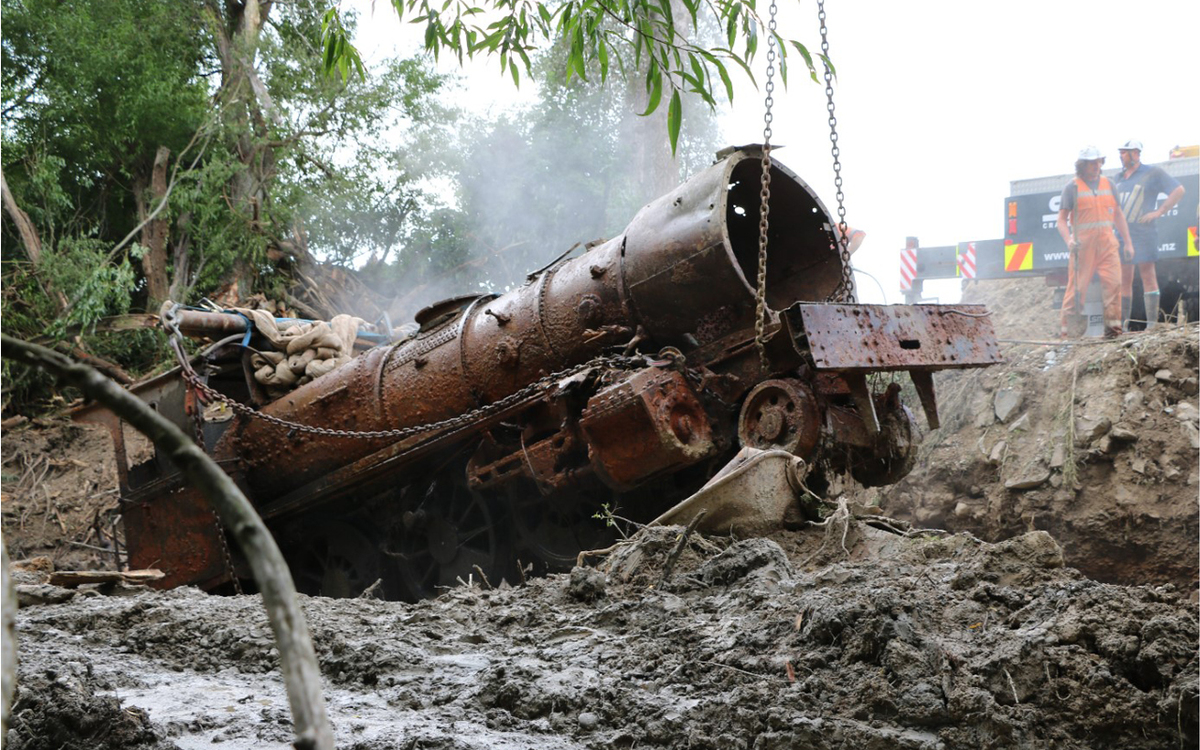 The recovery of two V Class locomotives and their coal tenders from the mud of the Mararoa junction near Lumsden in January and February 2020 was a mammoth logistical effort. PHOTO: SDC
The recovery of two V Class locomotives and their coal tenders from the mud of the Mararoa junction near Lumsden in January and February 2020 was a mammoth logistical effort. PHOTO: SDCJohn Titter admits he’s no train enthusiast. But as chair of the Lumsden Heritage Trust no-one has done more in the past seven years to promote the township’s rich rail heritage.
Together with Rob Scott and Robin Keach, John organised the recovery of two 19th century locomotives from their muddy grave in northern Southland.
John is quick to point out it’s a team effort. “I’m just the conductor of the orchestra,’’ he says.
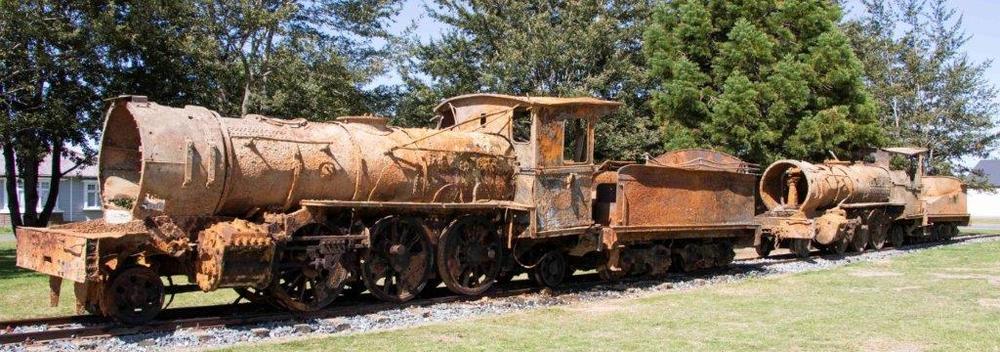
The recovery of the two V Class locomotives and their coal tenders from the mud of the Mararoa junction near Lumsden in January and February 2020 was a mammoth logistical effort. Around 20 men, four contracting companies, multiple pieces of heavy machinery and equipment and a host of local service organisations and businesses were involved in the successful effort to salvage the two historic steam engine sets.
The rusty mechanical wonders now rest proudly in the Lumsden Heritage Precinct where they can be enjoyed for many years to come by visitors from around the globe.
John and Rob – a Lumsden businessman and first-term Southland District councillor – in particular have lived and breathed the project for six years. John was running on fumes and adrenaline near the end as the two locomotives came out of the mud in two separate excavations on 28 January and 27 February.
John has farmed near Lumsden for 21 years and always been an active member of the community, including time as a Lions Club member. However, it was his vision for Lumsden to become a rail heritage centre that really lit his fire.
He recalls the genesis of his idea for what would become the Lumsden Heritage Trust, which is doing remarkable work in the township after being established in November 2013.
“The Lumsden railway station at that stage didn’t have any freedom camping and it was just gravel.
“I came up with this idea that it needs a steam train. I formed this little group called the Lumsden Steam Train Project and I went to a CDA (community development area subcommittee) meeting one day in Lumsden and said ‘what about a steam train?’
“They said they liked the idea but there’d be no money for it. Rob Scott was the chairman and he got hold of Bobbi Brown at Venture. We sat down and came up with an idea.
“Bobbi Brown was instrumental in the formation of the Lumsden Heritage Trust. Through that she gave us the guidelines and the channels to set up a trust and what we needed to do to achieve funding.
“From there we’ve gone from strength to strength. To date there’s probably been $350,000 raised for projects in and around the Lumsden Railway Precinct, which I think is fantastic.”
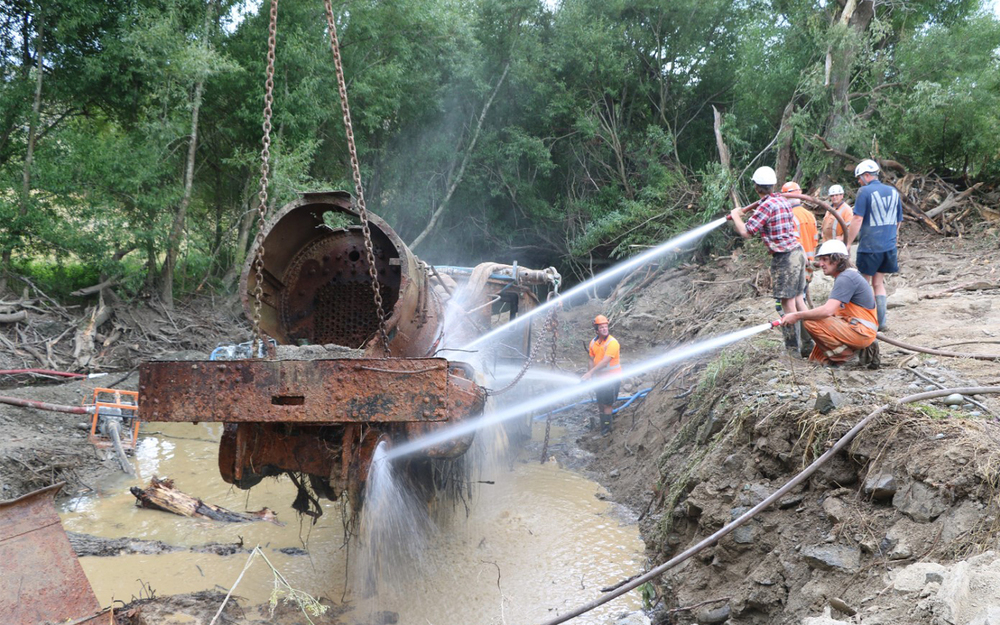
Among the trust’s achievements in its seven short years so far are securing two industrial locomotives, one from AFFCO and another that served in the Waihi goldfields, the chassis of a P Class locomotive, New Zealand Rail wagons that are leased from the Rail Heritage Trust of New Zealand, a railway station including crane, and a jail from the Lumsden camping grounds. In future, the trust plans to establish a rail heritage museum in Lumsden.
In recent years the attention of the trust has been firmly focused on extracting the two V Class locomotives from the Mararoa junction, a tributary of the Oreti River near Castlerock, 5km northwest of Lumsden.
The locos had been there since 28 October 1928, when they were dumped into the river bed to help form a flood protection wall. The locomotives were built specifically for New Zealand in 1885 in Manchester, England, and are probably the last remaining largely intact V Class locomotives in the world.
“The V Class followed the little Rogers K Class,’’ John says. “About 1877 they realised the K Class were too small and weren’t meeting the freight demand – they couldn’t pull heavy loads.
“The V Class were specifically designed for New Zealand conditions. The ones in the river here started serving in late 1885 and 1886 and served for about 30 years.
“New Zealand Rail had a surplus stock of old locomotives, cabs and boilers post World War I and they didn’t know what to do with them.’’
They were worthless as scrap metal and the best suggestion was to roll them into rivers where they could form the base for flood banks. This happened at least eight sites around New Zealand, including Branxholme near Invercargill.
The site near Lumsden is where Mandeville’s beautifully restored Rogers locomotive K92 was dumped in 1927. That locomotive was pulled from the mud in 1985 by the Fiordland Vintage Machinery Club.
“It was actually pretty cunning of whoever it was that came up with the idea of flood protection,’’ John says. “It was very beneficial to us 93 years later that we have the opportunity to get them out, whereas if they’d been scrapped there would have been no opportunity at all.”
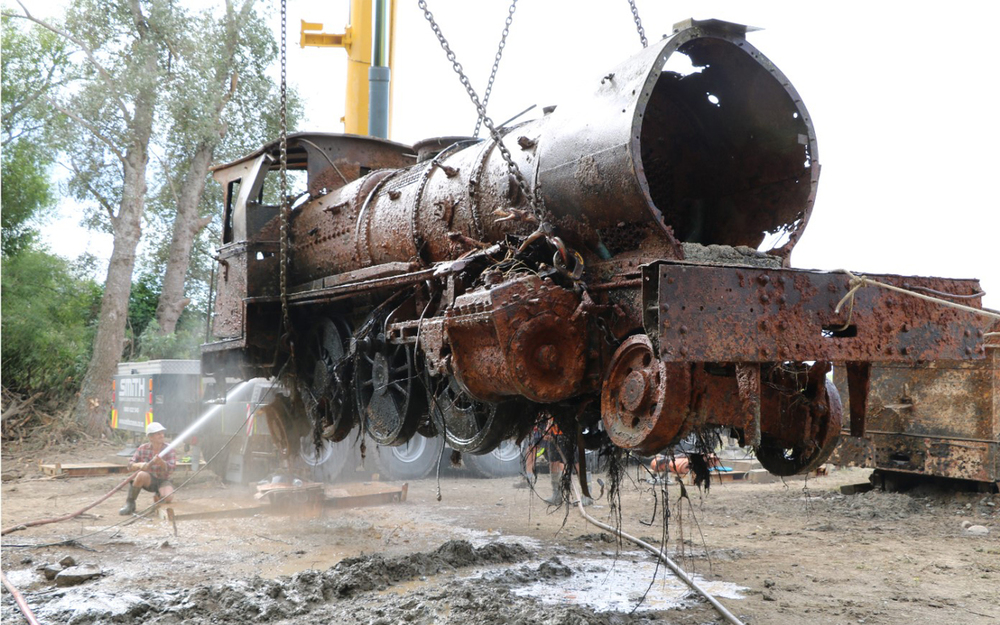
Initially the Lumsden Heritage Trust had a five-year consent to remove the two old V Class machines but they got busy developing the Lumsden Railway Precinct.
Eventually, landowner Roger Hamilton asked if the trust intended to get the locos out as he wanted to do some extensive flood protection on the site which would have prevented any chance of future recovery. Biting the bullet, John gave a commitment that they would try to do it within a year.
The trust started looking at regional funding opportunities through Southland District Council in October 2018 and got a favourable response. Funding was secured from organisations including the Lottery Grants Board, Community Trust South, Northern Southland Development Fund, Rail Heritage Trust of New Zealand, Communities Initiatives Fund and the Regional Heritage Fund.
Next they had to figure out how they could get the locomotives out of the ground in one piece. Tim Smith, of Smith Crane and Construction Ltd, and Russell Bradley from Linton Contracting came to look at the site in January 2019 and concluded it was do-able.
The total budget was $158,000, reduced markedly from face value because of the goodwill of the contractors involved, most notably Tim Smith of Smith Crane and Construction, whose “generosity was the cornerstone of this project”.
A year later, on 27 January 2020, the diggers moved in and work began. Earth was skillfully scooped away around the visible portions of the locomotives and their coal cars, and high-pressure hoses were played constantly over the steel hulks to remove the encrusted silt as more of the machines became visible.
Although relatively small by locomotive standards, the engines still weigh around 32 tonnes each, with several more tonnes of silt, mud and tree roots needing to be waterblasted off before iron-nerved crane driver Gerry Wilson could deadlift them out the mud.
On the 28th the coal tender came out, followed at 10.25am the following day by the locomotive V127 itself.
As John stood on the bank watching the concerted he said the moment was “a little surreal”.
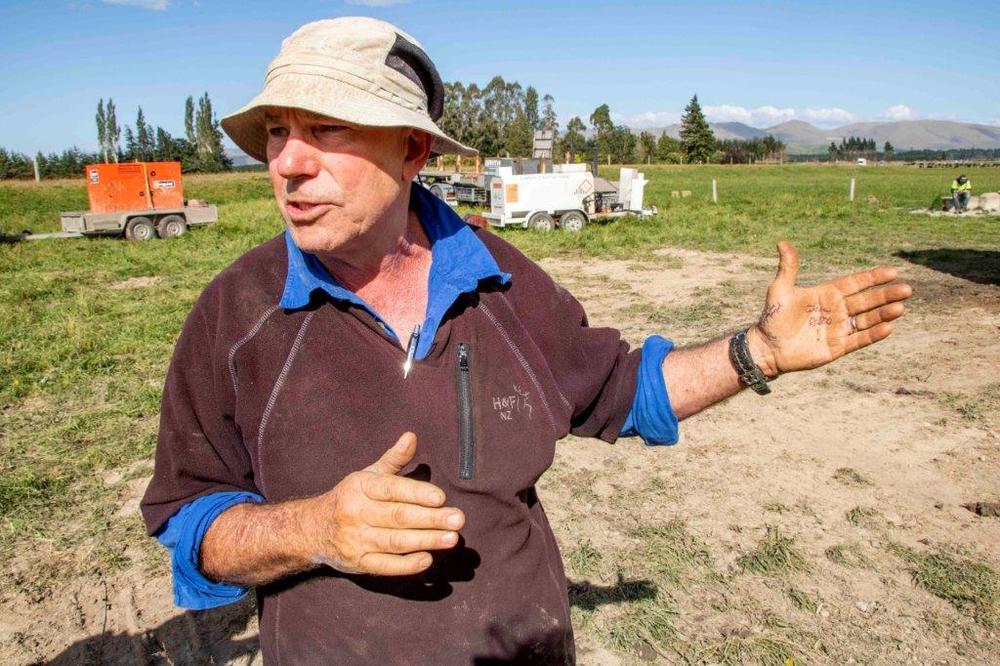
John Titter
Back at the site a month later, V126 came out of the mud, unexpectedly quickly, thanks to an ingenious stropping and winching technique which freed it from the suction of the mud.
Unlike the first extraction, John kept the second lift attempt out of the blaze of media scrutiny because the crew weren’t certain they could get the locomotive out in one piece.
“When it was pointing to the bank and we talked about the deadlift we thought we had another half day of cleaning off and getting the weight off it with hoses, but it was just bang on to get out.”
He describes the eerie quiet of the moment when V126 was raised on to the bank, a day earlier than they expected.
“We had it over on the other side of the bank and then when we pulled the front across, and eventually the suction let go, when we lifted the front up and put a log underneath it cantilevered for a while. We wondered what was going to happen. It nearly tipped over at one stage.
“We managed to keep it on the log, balancing like on a seesaw. It was quite unbelievable.
“There was just silence. It was quite surreal. Absolute silence. I think even the birds stopped tweeting.
“Gerry tried to pick it up and it got to that tipping point where they just decided to go for it.
“It came up and up and up and up and it got the edge of the bank and he slewed it across on to the grass and we just couldn’t believe it.
“It was a weird moment, but it was a great moment.”
John is thrilled that they managed to get both locos out. It provides an added attraction for visitors to Lumsden and steam enthusiasts everywhere.
“This locomotive (V126) has features on it that the other one didn’t. The exhaust manifold on the front is pretty complete. They’ve got some extension rods that aren’t on the other one. This one’s cab’s a bit more damaged and there’s a bit more boiler damage than the other one. They are different in their own way but I think that’s good.
“Whoever visits gets to enjoy parts of one that aren’t on the other, and vice versa.”
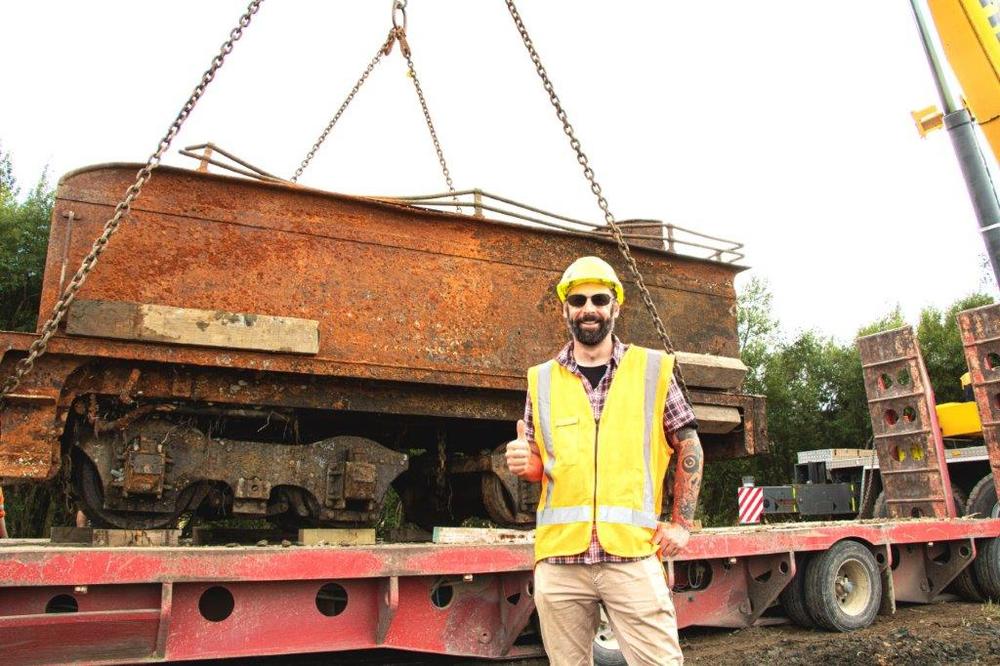
Rob Scott
As far as John and the Lumsden Heritage Trust are concerned, it’s mission accomplished. John says there’s the opportunity there for someone to restore the locomotives, but that someone won’t be him.
“I love what I’m doing, I love project managing. I really enjoy the interaction and networking that I get to do through being on the trust and projects like this, but I’m not a train enthusiast and I think those sort of projects are lifetime projects.”
John praises the crew who joined forces to carry out the remarkable recovery job, namely Linton Contracting, Smith Cranes and Construction, Southland Machine Hire and Castlerock Contracting. “You’d be hard pressed to find a crew of such experience and quality.” He also thanks the Hamilton family, Bobbi Brown from the former Venture Southland, Southland District Council and Environment Southland.
In particular he singles out Clark McCarthy, the chairman of Otago railway preservation society Project Steam, for the inspiration and energy he brought to the project. “Without him we wouldn’t be here. His enthusiasm and can-do attitude is what’s propelled me and our trust forward to do this.”
While on site the team also recovered the cab off a P Class locomotive that will go to a similar rail heritage display in Middlemarch, being driven by Clark. John says it’s “payment for all the help he’s given us over the last six years”.
The trust had great support from the Lumsden community, he says.
“I think people have had a massive amount of buy-in to this. I believe they feel ownership with these locomotives, considering they ran on their track. They’re all part of the rail heritage and history here.
“I think they’re going to be great for the town.”
Already there has been a groundswell of interest from tourists and steam train enthusiasts, including glossy British rail publications.
What next for John Titter? “I’m going surfing.’’
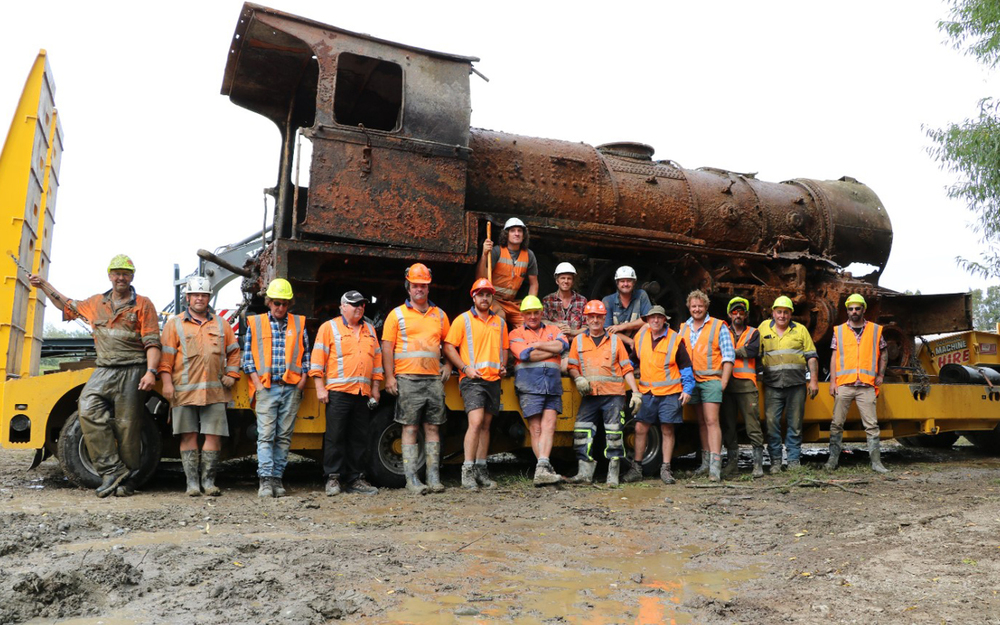
– This article was produced for the Southland District Council's First Edition magazine that was unable to be published due to COVID-19 restrictions.
AG | TRADES & SUPPLIES


